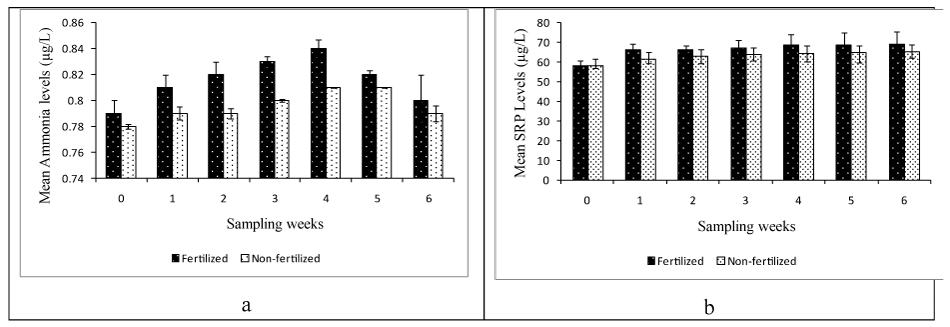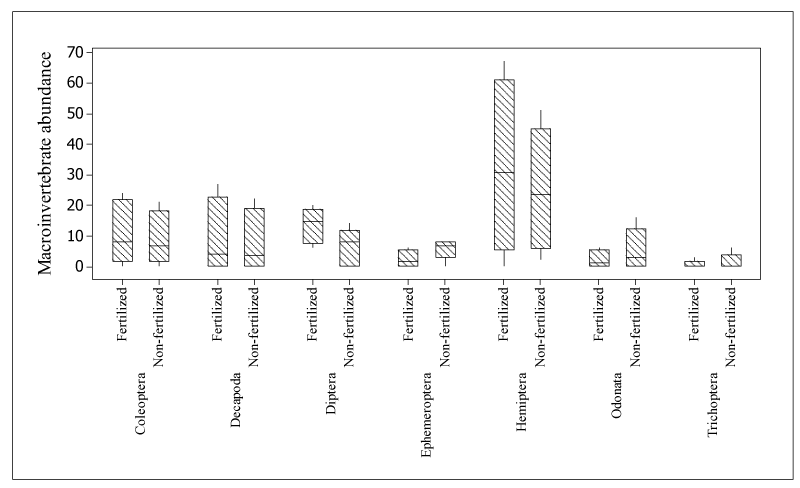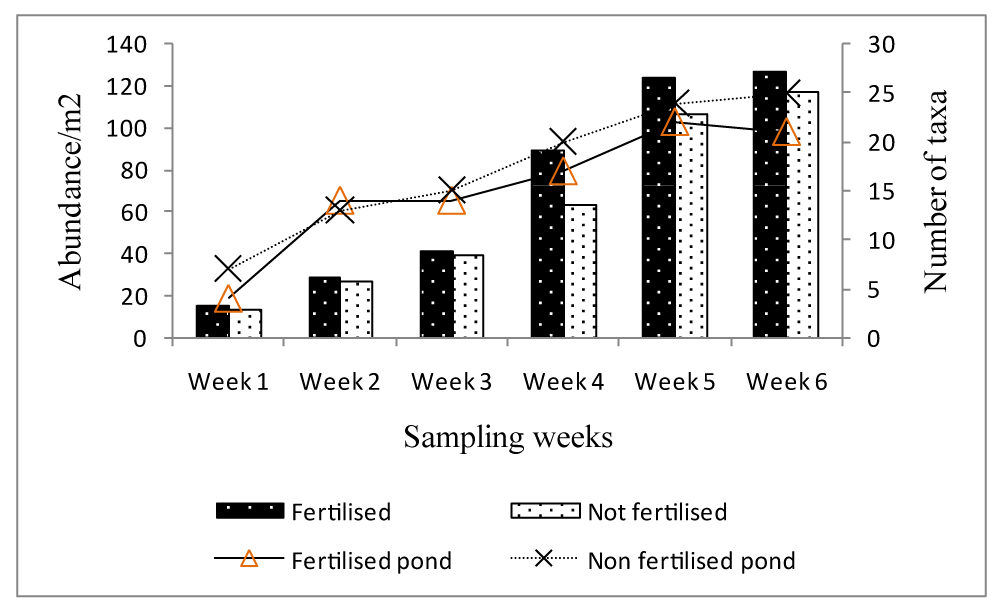International Journal of Aquaculture and Fishery Sciences
Colonization patterns of benthic macroinvertebrates in fertilized and non-fertilized earthen fish ponds
Patrick O Orwa1*, Reuben Omondi2 and Emily J Chemoiwa3
2Kisii University, Kenya
3University of Eldoret, Kenya
Cite this as
Orwa PO, Omondi R, Chemoiwa EJ (2018) Colonization patterns of benthic macroinvertebrates in fertilized and non-fertilized earthen fish ponds. Int J Aquac Fish Sci 4(3): 022-026. DOI: 10.17352/2455-8400.000039Study conducted in Kwanza, Trans-Nzoia County to determine the colonization pattern of benthic macroinvertebrates in earthen fish ponds. This was done to ascertain the right stocking time of ponds when the natural fish food is in plenty. Two ponds were used for this study; one was treated with organic manure while the other was not fertilized. Sampling for physico-chemical parameters were then taken immediately after filling the ponds and repeated weekly for six weeks while benthic macroinvertebrates were first sampled after week 1 and repeated weekly for six weeks. The results obtained were compared between the two treatments and per treatment over time. There were significant differences in most parameters over the weeks and between the treatments. Attainment of suitable conditions for stocking was however at week 3 for fertilized and week 4 for the non-fertilized contrary to the usual two week period advised by most procedures.
Introduction
Capture fisheries cannot be expanded beyond its natural productivity and as a result aquaculture is becoming an important source of animal protein for human consumption [1]. According to [2], aquaculture production has realized over 40% growth over the previous two decades. Kenya has large and several natural water resources which include springs, wetlands, water reservoirs, temporary water bodies, lakes, rivers and marine waters that provide a huge potential for not only the wild fisheries but also aquaculture development [3]. The vast water resources favor the culture of a wide variety of fish species both marine and freshwater [4]. According to [5], aquaculture presently accounts for about 2.5% of total fish production in Kenya. This scenario is partly due to the inability of the country to exploit the available resources and the small scale and limited aquaculture development [4].
According to FAO [6], aquaculture in Kenya was at its infancy stage but had the potential to change the estimated natural fish production three-fold. Aquaculture provides a source of subsistence and livelihood to the fish farmers and the local community [7]. There is also a poor reception of aquaculture as an economic activity in Kenya which has made it difficult to commercialize the enterprise [8]. The poor reception is partly due to the low growth rate witnessed by most small scale farmers whose fish hardly attain table-size. There are sTipulated procedures to be followed in order to achieve better results at the end of the production time (Ngugi et al., 2007). The procedure includes pond fertilization two weeks prior to stocking in an attempt to enhance natural pond productivity. This study thus seeks to determine the colonization pattern of macroinvertebrates within fertilized and non-fertilized ponds in the Kenyan highlands. This will provide vital information on availability of natural food in terms of benthic macroinvertebrates as an indicator of when to stock after fertilization.
Materials and Methods
This study was conducted in Lake Basin development Authority fish farm in Kwanza constituency, Trans-Nzoia County, Rift Valley province, Kenya. Two ponds were use for the study, one fertilized with organic manure and the other not fertilized. Both ponds were first limed then fertilization done in one pond at a rate of 50g/m2 according to Ngugi et al (2007). After liming and fertilization, water was allowed in until recommended level before sampling. Sampling for physico-chemical parameters was done immediately the ponds were full. From each pond, four samples were taken in-situ for Dissolved Oxygen, temperature, pH, and conductivity using portable water quality meters. Benthic macroinvertebrates were sampled in triplicates using a 500µm mesh size scoop net, sorted live and preserved in absolute ethanol. In the laboratory, the specimen were identified to genus level and where possible species.
The identified macroinvertebrates were analyzed for diversity and abundance per week for every treatment. The taxa were further grouped into their feeding guilds based on mouth morphology and existing literature. The feeding guilds were summarized in terms of relative abundance and represented in form of pie-charts and bar graphs.
Results
Physico-chemical parameters
Table 1, shows the results of mean weekly physico-chemical parameter values per treatment. Dissolved Oxygen was relatively similar at the start with the two treatment showing no significant variation (p = 0.248). This changed with time and at the end of the six week study, the two treatments had widely different mean values of 2.46 ± 0.02 for fertilized pond and 2.27 ± 0.02 for the non-fertilized. One way ANOVA further revealed significant variation between the two sets of treatment (p = 0.031). On a temporal scale, both fertilized and non-fertilized ponds showed significant differences with values of p < 0.001 for both treatments (Table 1). Just like DO, temperature values increased significantly over time. However, the fertilized ponds attained the tolerable lower limit of 22°C earlier (week 3) as compared to the non-fertilized one where the minimum limit was attained at after five weeks. The values of pH remained around neutral with 6.8 at the start and 7.3 at week six for both the treatments. This is typically the best pH range for fish farming. Conductivity increased over time probably due to increasing presence of both dissolved and suspended solids coupled with living matter in form of plankton community, macroinvertebrate community, and the frogs.
Nutrients
The nutrients examined in this study include ammonia and soluble reactive phosphorus (SRP) which are nutrients of major concern in an aquaculture facility. Ammonia values showed insignificant increments over the weeks for both fertilized and non- fertilized ponds (p = 0.065 and p = 0.075, respectively). The values however remained far below the detrimental limits and were thus not a cause of alarm. As concerns SRP, there was significant temporal difference for both treatments whereby the values were increasing over time. The treatments on the other hand showed similar results at the start but diverged over time with the fertilized ponds showing higher values than the non-fertilized figure 1.
Macroinvertebrate community attributes
Colonization pattern: From the six week sampling period table 2, a total of seven orders, twenty families and thirty three genera were identified from the study ponds. The ponds were first colonized by four species of mosquito larvae (Aedes sp, Culex territans, Mansonia sp, and Anopheles crucians). All the four species were sampled from both ponds in week 1 though the non-fertilized pond had other three species which are Baetis sp, Gerris sp, and Limnogonus sp. After the second week, there were two different species of water beetles (Copelatus astrosulcatus, and Aulonogyrus sp) in the fertilized ponds in addition to the four Culicidae genera. The other taxa sampled from the fertilized pond included Baetis sp, Limnogeton expansum, Sphaerodena nephroides, Micronecta eupompe, Gerris sp, Limnogonus sp, Chironomus sp, and Tipula sp. In the non-fertilised ponds, Chironomus and Anopheles were missing but recorded Ranatra cinamomea. In week 3, the two mosquito species disappeared from the samples while the predatory Hemipterans began to dominate while in week 4. After week 4 the ponds were completely dominated by water bugs in addition to appearance of other taxa such as Decapoda, Odonata, and Trichoptera.
Macroinvertebrate abundance: Among the orders sampled, Hemiptera (water bugs) were the most dominant while the least dominant was the order Trichoptera figure 2. The other orders were relatively similar in terms of abundance. The high abundance of Hemiptera, more so the predatory Belastomatidae is not good enough for aquaculture since it preys on zooplankton and mosquito larvae, a major natural food for fish.
Week 1 sampling recorded densities below 20 individuals/m2 for both fertilized and non-fertilized ponds. The densities then increased in week 2 all the way to week 6 with Kruskal-Wallis test showing significant variation between the weeks (p = 0.021). However, pair wise comparison grouped together weeks 1, 2, and 3 in one sub-set and the remaining three weeks in another sub-set. Apart from weeks 4 and 5, the densities between ponds did not vary significantly though in all weeks the fertilized ponds had higher densities in all samplings. The higher density can be attributed to presence of food in form of particulate organic matter and detritus in the manure used for fertilization coupled with increased primary productivity from algae due to presence of nutrients. Presence of particulate organic matter and detritus in an aquatic system provide food for benthic fauna thereby increasing their diversity and densities figure 3.
Macroinvertebrate Functional Feeding Groups: In both ponds, there were five functional feeding guilds identified though they occurred in some pattern. In week 1, both ponds only recorded two guilds; filter feeders and predators with filter feeders dominating figure 4. During the second week, the fertilized pond recorded a third feeding guild, grazers while the non-fertilized, apart from the grazers, there were also the scrapers in small proportions. While the proportion of predators increased over the weeks in the fertilized pond, it decreased in the non-fertilised probably due to limited food as a result of low productivity. Availability of zooplankton and other small macroinvertebrates depends on primary production which is influenced by presence of nutrients and other physico-chemical parameters. From the third week, all the five feeding guilds were recorded with that of scrapers increasing.
Discussion
Water quality parameters
Dissolved Oxygen and temperature were observed to vary over time though not between the treatments. The variation was probably due to increasing abundance of photosynthetic algae, and the ability of suspended solid to retain heat and generation of more heat by the colonizing organisms. Algae are photosynthetic and produce oxygen during the process of photosynthesis. Research has shown positive correlation between algal abundance and oxygen during the day [9]. Just like temperature, the increase in conductivity was probably due to total solids and colonizing organisms. Temperature and Conductivity in ponds are dependent on suspended solids and living organisms therein.
Ammonia and SRP levels did not show significant variation both on temporal and spatial scales, an indication that organic fertilization does not influence the concentration of ammonia in ponds which is in agreement with [10], who investigated the influence of organic fertilization on nutrient levels in ponds. However, nutrient levels have been shown to increase with increasing protein content in feeds above recommended levels or generally poorly formulated feeds [11], which was not the case in this study.
Macroinvertebrates
The absence of mosquito larvae from the samples after week 3 can be attributed to high predation by the water bugs. Giant water bugs have been shown to feed on dipteral larvae with preference on Culicidae. Studies have shown significant negative correlation between Belastomatidae and Culicidae families [12,13]. The presence of the bottom feeding Procambarus clarkii is also a drawback to production of tilapia fingerlings since it destroys the nests coupled with increasing water turbidity and causing cracks within ponds that leads to leakages. Studies have shown that Procambarus clarkii not only presents stiffer competition for food with fish but also destroys macrophyte beds that support juvenile fish [14]. The increasing diversity and abundance observed is probably as a result of the expanding niche arising from fertilization of both allochthonous and autothonous origin. The expanding niche can further be confirmed by increasing FFGs over time. Previous studies have shown that there is a positive correlation between organic matter content in aquatic systems and macroinvertebrate diversity and abundance [15,13]. This is further corroborated by the findings of this study where fertilized pond faster colonization and higher densities.
Conclusion
Water quality values and macroinvertebrate colonization pattern vary significantly between the fertilized and non-fertilized ponds in the Kenyan highlands. Temperature reached tolerable limits of above 20°C after the second week in the fertilized pond while after week 3 within the non-fertilized one. Concerning pH, the water was initially acidic but became neutral after one week for both fertilized and non-fertilized ponds. Macroinvertebrate density increased and reached a relatively good level for food base during week 4 for the fertilized and week 5 for the non-fertilized. This is an indication that the duration of stay before stocking varies based on treatment and region. The two week recommended in most procedures could be specific for warm climate areas.
Recommendation
Based on the results, we recommend a further study to compare the response of ponds between high and low altitude regions. The study should include all aspects of culture environment such as water quality, phytoplankton succession, zooplankton succession and benthic macroinvertebrates.
- FAO (2008) The State of Food and Agriculture; Biofuels: Prospects, Risks and Opportunities. Rome: Food and Agriculture Organization of the United Nations. Link: https://tinyurl.com/yddc4st8
- FAO (2013) A global assessment of offshore mariculture potential from a spatial perspective. FAO Fisheries and Aquaculture Technical paper T549, Rome – Italy. Link: https://tinyurl.com/y9r5wvgj
- Rothuis A, van Duijn AP, van Rijsingen J, van der Pijl W, Rurangwa E (2011) Business opportunities for aquaculture in Kenya with special reference to food security. The Hague: Wageningen UR. Link: https://tinyurl.com/ybu5fg7n
- Government of Kenya (2010) The Kenya Vision 2030 Ministry of Planning. Nairobi, Government printers. Link: https://tinyurl.com/yavef6o7
- Government of Kenya (2007) Characterization of fish production and marketing practices.
- FAO (2005) Aquaculture production 2004. Year book of Fishery Statistics - Vol.96/2. Food and Agriculture organization of the United Nations, No.5. Rome, Italy. Link: https://tinyurl.com/ybjhpxgj
- Ngugi CC, Manyala JO (2009) Assessment of National Aquaculture Policies and Programmes in Kenya. Nairobi, Sustainable Aquaculture Research Networks in Sub-Saharan Africa (SARNISSA). Link: https://tinyurl.com/ycgmqd8a
- Mbugua HM (2008) Aquaculture in Kenya: Status, Challenges and Opportunities. Directorate of Aquaculture Development, Kenya. Link: https://tinyurl.com/y8gtycho
- Iwama GK (2009) Interactions between aquaculture and the environment. Critical Reviews in the Environmental Control 21: 177–216. Link: https://tinyurl.com/yadgyrau
- Oyoo-Okoth E, Cherop L, Ngugi CC, Chepkirui-Boit V, Manguya-Lusega D, et al. (2011) Survival and physiological response of Labeo victorianus (Pisces: Cyprinidae, Boulenger 1901) juveniles to transport stress under a salinity gradient. Aquaculture 319: 226–231. Link: https://tinyurl.com/y8h2xaw6
- Bergheim A, Asgard, T (2014) Waste production in aquaculture. In: Baird, D. J., Beveridge, M. C. M., Kelly, L. A., Muir, J. F. (Eds.), Aquaculture and Water Resource Management. Blackwell Science, Oxford 50-80. Link: https://tinyurl.com/yc6ra659
- Ofulla AV, Karanja OD, Omondi R, Okurut T, Matano A, et al. (2010) Relative abundance of mosquitos and snails associated with water hyacinth and hippo grass in the Nyanza gulf of Lake Victoria. Lakes& Reservoirs: Research and Management 15: 255-271. Link: https://tinyurl.com/y7wry5t6
- Orwa PO, Omondi R, Ojwang W, Mwanchi J (2015) Diversity, composition and abundance of macroinvertebrates associated with water hyacinth mats in Lake Victoria, Kenya. African Journal of Environmental Science and Technology 9: 202-209. Link: https://tinyurl.com/yc7hkp3n
- Light T (2005) Behaviour effects of invaders: alien crayfish and native sculpin in a California stream. Biological Invasions 7: 353–367. Link: https://tinyurl.com/ybkyeos9
- Masese FO, Raburu PO, Muchiri M (2009) A preliminary benthic macroinvertebrate index of biotic integrity (B-IBI) for monitoring the Moiben River, Lake Victoria. African Journal of Aquatic Science 34: 1-14. Link: https://tinyurl.com/ybmooonb

Article Alerts
Subscribe to our articles alerts and stay tuned.
 This work is licensed under a Creative Commons Attribution 4.0 International License.
This work is licensed under a Creative Commons Attribution 4.0 International License.




 Save to Mendeley
Save to Mendeley
